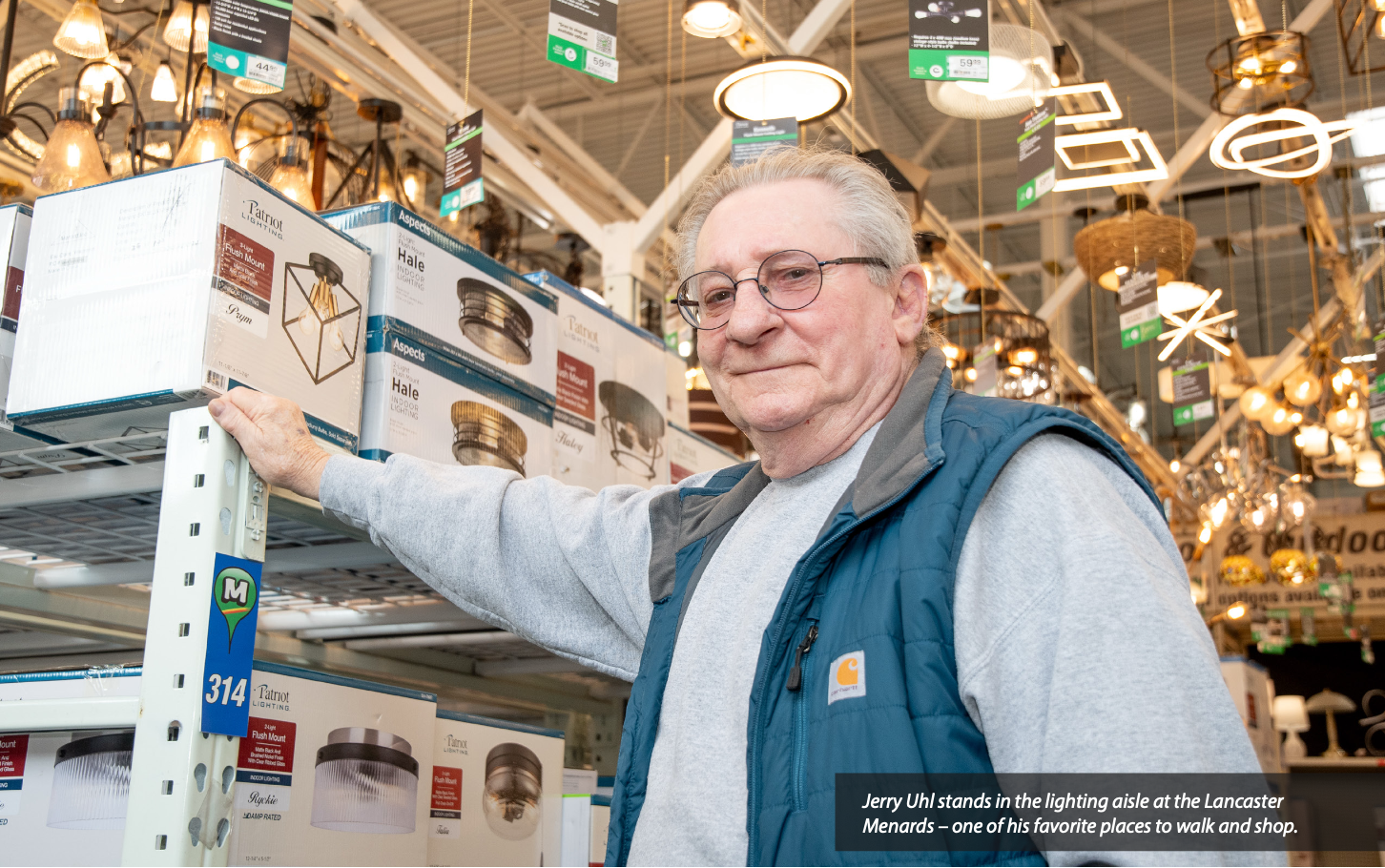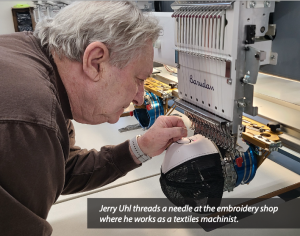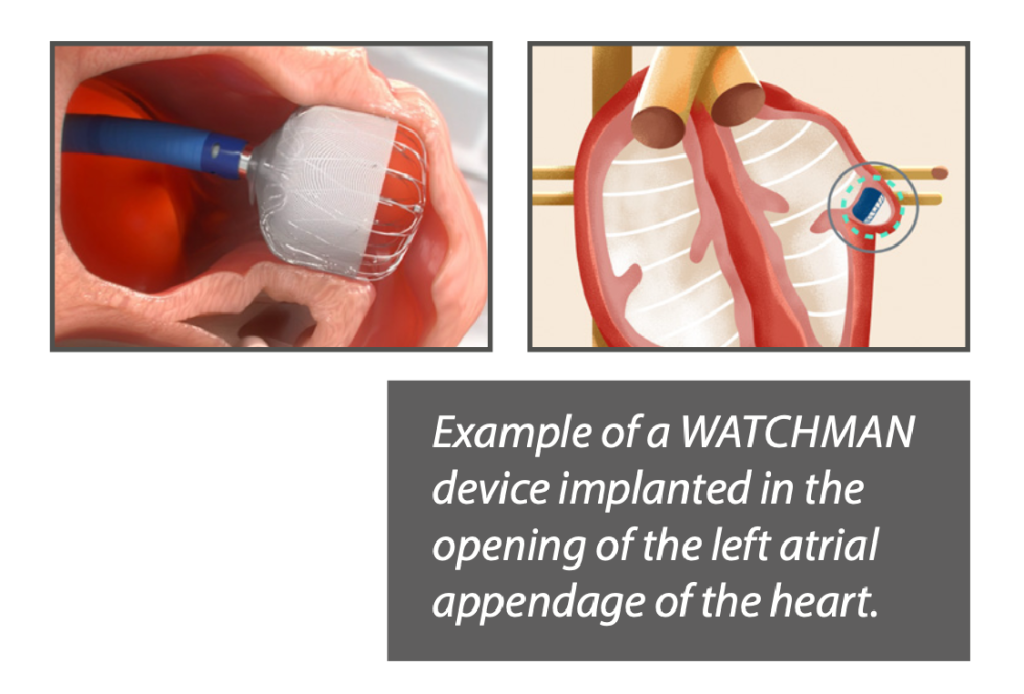Article originally published Spring 2025 in The Monitor publication.
WATCHMAN: Guarding Against Stroke – Jerry’s Journey

Jerry Uhl sees the world through his own lens. The Lancaster native, 73, spent decades working as a portrait photographer in Southeast Ohio, using his camera to capture fleeting moments and preserving them for a lifetime. Over the years, he has traded the fast-paced demands of event photography for leisurely snapshots of landscapes and tranquil pictures of nature.
 When he’s not working away at a local embroidery shop, he can be found repairing his summer house and fishing on the Muskingum River. These simple joys mean the world to Jerry, so when an unexpected hospital stay and subsequent diagnosis threatened to interrupt his peaceful lifestyle, Jerry turned to Fairfield Medical Center and a procedure known as WATCHMAN to help him overcome his health obstacles.
When he’s not working away at a local embroidery shop, he can be found repairing his summer house and fishing on the Muskingum River. These simple joys mean the world to Jerry, so when an unexpected hospital stay and subsequent diagnosis threatened to interrupt his peaceful lifestyle, Jerry turned to Fairfield Medical Center and a procedure known as WATCHMAN to help him overcome his health obstacles.
In November 2022, Jerry found himself in Fairfield Medical Center’s intensive care unit with pneumonia. When the illness in his lungs later progressed to sepsis – a life-threatening complication of infection – he was in dire straits. Thankfully, with IV antibiotics and a lot of dedicated care, Jerry began to improve. But as his hospital stay continued, a new development in his health was discovered.
 “I was in bed and a nurse came in acting very concerned,” Jerry remembered. “She said my heart was in afib – I had never been told that before. I’m not sure when we would have caught it if I wasn’t already in the hospital.”
“I was in bed and a nurse came in acting very concerned,” Jerry remembered. “She said my heart was in afib – I had never been told that before. I’m not sure when we would have caught it if I wasn’t already in the hospital.”
Afib, or atrial fibrillation, is an abnormal rhythm that occurs when the heart beats in a rapid, uncoordinated way. Normally, the heart’s chambers work together to fill and then pump blood to the body in a steady and predictable pattern. During afib, however, the upper chambers of the heart flutter instead of squeezing, weakening the heart’s pumping power and causing blood to pool in the heart. When this happens, blood clots can form, and the risk of stroke rises dramatically.
“People with afib are five times more likely than the general population to have a stroke,” said cardiologist and electrophysiologist Michael Reinig, DO, of Fairfield Healthcare Professionals Cardiology. “Unfortunately, strokes related to afib are often more damaging and can result in a high degree of disability or death, which means prevention is of the utmost importance.”

Once recovered from his hospitalization, Jerry met with interventional cardiologist John Lazarus, MD, PhD, at FHP Cardiology to discuss a treatment plan. The first line of defense for decreasing stroke risk included daily blood thinners to prevent clots from forming. Doctors started Jerry on an oral anticoagulant, and the treatment seemed to work well for nearly two years. That is, until Jerry’s blood work revealed an undeniable problem – his red blood cell count was dangerously low.
While blood thinners are incredibly effective at keeping blood cells from sticking together, they can lead to complications. For some, this might mean bleeding excessively from minor scrapes and scratches. For others, the bleeding might be internal, particularly in the stomach or urinary tract. If these bleeding problems are not addressed, they can result in anemia, or a low level of healthy red blood cells, which are responsible for carrying oxygen throughout the body. Jerry immediately began working with certified nurse practitioner Megan Brown of FHP Hematology/Oncology, to correct the problem through iron infusions. Next, he needed to find an alternative way to manage his stroke risk, which led him back to Dr. Lazarus.
“Blood thinners are not always the best choice for patients with afib who have a history of bleeding complications or who later develop them, like Jerry,” Dr. Lazarus explained. “Fortunately, there is a procedure that can reduce the risk of stroke by up to 90 percent without the use of anticoagulants. It’s called WATCHMAN, and we’re able to perform it right here at FMC.”
 WATCHMAN focuses on closing the left atrial appendage, a section of the heart where nearly all afib-related blood clots form. During the minimally invasive procedure, a small incision is made in the leg and a catheter is guided to the heart. The WATCHMAN device is then implanted within the opening of the left atrial appendage, where it acts as a plug. Eventually, tissue grows over the device, creating a permanent seal. Recovery is often quick and follow-up relatively painless.
WATCHMAN focuses on closing the left atrial appendage, a section of the heart where nearly all afib-related blood clots form. During the minimally invasive procedure, a small incision is made in the leg and a catheter is guided to the heart. The WATCHMAN device is then implanted within the opening of the left atrial appendage, where it acts as a plug. Eventually, tissue grows over the device, creating a permanent seal. Recovery is often quick and follow-up relatively painless.
“This past November, I had the procedure on a Thursday, and I was back to work by Monday,” Jerry said. “It was as quick and easy as you can expect a surgery to be. Dr. Lazarus adjusted my medications, and then after 45 days, I was able to stop taking my blood thinners completely.”
Now, more than two years after his initial afib diagnosis and a year since discovering his anemia, Jerry is living without fear of stroke – and without the limitations of blood thinners. As a self-proclaimed handyman and avid fisherman, Jerry doesn’t think twice about the nicks and scrapes that come with the job of home repairs or reeling in a monster catfish. In fact, as the weather warms, he doesn’t think about his afib at all. He’s simply happy to return to the river, tick the maintenance projects off his to-do list and cast a line – with his camera nearby, of course.
Learn more about Fairfield Medical Center’s Heart & Vascular Services.
